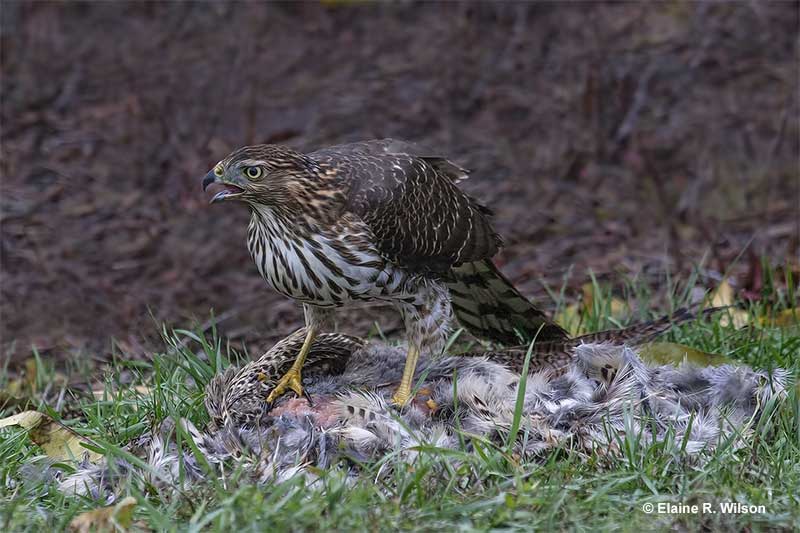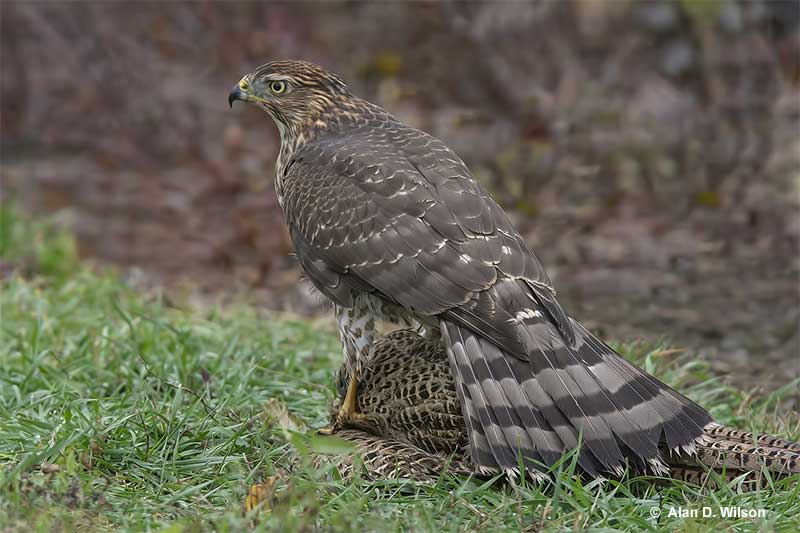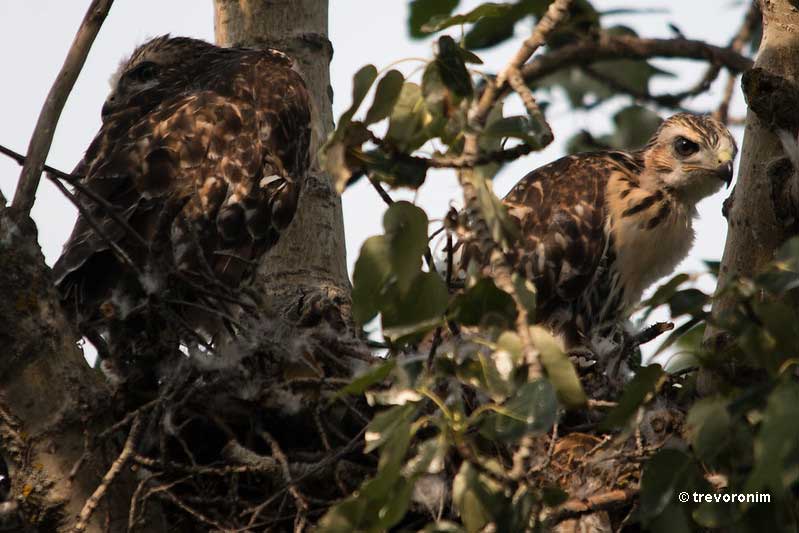
Hawks are impressive birds! We can see these big raptors soaring high overhead, perched near roads, and sometimes right around the house. However, they aren’t exactly visiting backyard birdfeeders to eat sunflower seeds.
Their sharp talons and fierce hooked beaks hint at another, more carnivorous diet. But what exactly do hawks eat? Do small hawks eat different things than bigger species? See this article to learn the answers to these questions and more about what hawks eat!
On this page
What Do Hawks Eat?
Hawks eat other animals. Unlike birds that feed on seeds and bugs, hawks are meat eaters. Their diets mostly consist of small animals that they catch with their sharp, needlelike talons.
Depending on the species, hawks can eat small mammals, rodents, birds, reptiles, and even insects. To avoid competition with each other over food, some hawks specialize in eating birds, others mostly catch small rodents, and a few hawk species eat a lot of frogs and snakes.
For example, the Cooper’s Hawk, a species that commonly visits backyards, mostly eats birds and squirrels. The similar but smaller Sharp-shinned Hawk only eats small birds, whereas the Northern Harrier is a type of hawk that catches small birds, rodents, and other small animals in open fields and marshes.
Related: How much weight can hawks carry?
The hefty Red-tailed Hawk is a common and adaptable hawk that lives in all sorts of places, even in cities! This species eats just about anything it can catch. Its diet includes squirrels, rabbits, rats, mice, snakes, and birds. In New York City and some other urban areas, pigeons also make up a large part of their diet.
In California and southern states, the Red-shouldered Hawk is a common species that eats lizards, frogs, small snakes, and other small animals.
Do Hawks Eat Other Birds?
Although many hawks eat mice and other small rodents, most hawks also eat birds. If the opportunity presents itself, most species will catch and eat smaller birds, even smaller hawks. For example, although Broad-winged Hawks tend to hunt slow-moving prey, if they see a small bird that is sick or in trouble, they might catch it.

Hawks often hunt down smaller birds, but in some cases, they can be around the same size. That takes some serious skill!
However, for some other hawk species, birds make up an important part of their diets. In particular, hawk species that belong to the Accipiter genus specialize on catching and eating birds.
In North America, our most common Accipiter is the Cooper’s Hawk. This powerful bird of prey eats medium-sized birds like Mourning Doves, Rock Pigeons, woodpeckers, and starlings. Like most Accipiters, it usually goes after birds that are smaller than itself.
Related: Eagle vs Hawk vs Falcon
The Sharp-shinned Hawk is a smaller Accipiter that preys on warblers, sparrows, and other small bird species, and the Northern Goshawk is a big raptor that eats grouse and other fair-sized birds.
How Do Hawks Hunt?
Hawks hunt for prey in a variety of ways. Each species also has adaptations and hunting strategies to help it catch certain types of animals. However, all hawks try to catch their prey by surprise.
One of the most common species, the Red-tailed Hawk, hunts in a few different ways. This adaptable hawk can soar high in the air, watch from a perch, or even hover in place. When it sees a mouse, squirrel, or snake, it dives down to snatch the animal with its talons.
Hawk species like the Broad-winged Hawk and Red-shouldered Hawk use similar strategies to catch their prey, often hunting from a fairly low perch. In open habitats of western North America, the Swainson’s Hawk and big Ferruginous Hawk hunt rodents by soaring. However, they can also hunt for prey while standing on the ground.
These raptors wait on the ground near prairie dog and ground-squirrel colonies to try and catch the rodents when they come out of their burrows.
The Cooper’s Hawk and other Accipiter species have to use stealthier strategies to catch their quick-moving prey. They watch from a concealed perch, wait to see an unwary bird, and then quickly fly and catch it.
What Do Baby Hawks Eat?
Baby hawks eat meat, even recently hatched hawks. However, their mother can also feed them bits of regurgitated food. In most hawk species, the male brings food to the nest for both the babies and the female.
After bringing a rat, bird, or other prey item, he leaves it in the nest and the female tears the prey apart. She gives her young bits of food, the size of the food being directly related to the size of the babies.
Species like the Swainson’s Hawk, and Broad-winged Hawk can also feed their babies grasshoppers and other large insects. However, most feed their babies small pieces of food by directly placing the meat in the baby’s mouth.

After four or five weeks, instead of feeding their young bits of meat, hawks bring their babies larger pieces animals or the entire prey item.
They do this so the young birds can learn to tear prey apart and feed themselves.
Some young hawks may even try to swallow a mouse or other animals whole! However, they usually tear at it with their sharp beaks, and may also practice clutching it with their talons.
After fledging, parent hawks can continue to feed their babies for another two months.
Fun Facts About Hawks And Their Feeding Habits
- Hawks almost always kill their prey before eating it. In common with most predators, they try to kill their prey as quick as possible. If not, their prey might bite or injure them in other ways.
- Hawk species kill rodents, birds, and other prey by clutching it with their sharp talons. Although they can also use their sharp and dangerous beaks, opening and closing their feet on a small animal is usually enough to kill it.
- After catching prey, hawks bring the animal to a perch where they can eat it in peace. Bird-eating hawks often remove the bird’s head and wings before eating it. However, some other species swallow small rodents whole.
- Although most hawks hunt on their own, Harriss’s Hawks in Arizona work together to catch Jackrabbits and other prey!
- To help them catch prey, hawks have excellent eyesight. A Red-tailed Hawk can spot a small mouse on the ground while soaring more than 100 feet above it!
- Hawks have nictating membranes to protect their eyes while hunting. This membrane is an extra eyelid that helps shield their eyes from wind and provides some protection from prey.
- Ferruginous Hawks east of the Rocky Mountains mostly prey on ground-squirrels and prairie dogs. Several can gather around a “prairie dog town”, and can also eat prairie digs killed by hunters. In such situations, they are attracted to gunfire and fly in to eat the dead rodents!
Frequently Asked Questions
Are hawks carnivores?
Hawks are carnivores. They feed on mammals, reptiles, birds, and even insects.
Do hawks eat any plant matter?
No, hawks do not eat seeds or other plant matter.
Is a hawk at the top of the food chain?
In some sense, hawks are at the top of the food chain. However, eagles are larger than hawks, so they occasionally go after smaller hawks and hawk nests.
Do hawks eat snakes and lizards?
Many hawks eat snakes and lizards. In some places, these small animals make up an important part of their diet. Red-tailed Hawks and Cooper’s Hawks are some species that like to hunt reptiles.
Do hawks eat ducks?
No, hawks don’t usually eat ducks. On occasion, a hawk can catch a sick or wounded duck but ducks are mostly preyed on by falcons.

